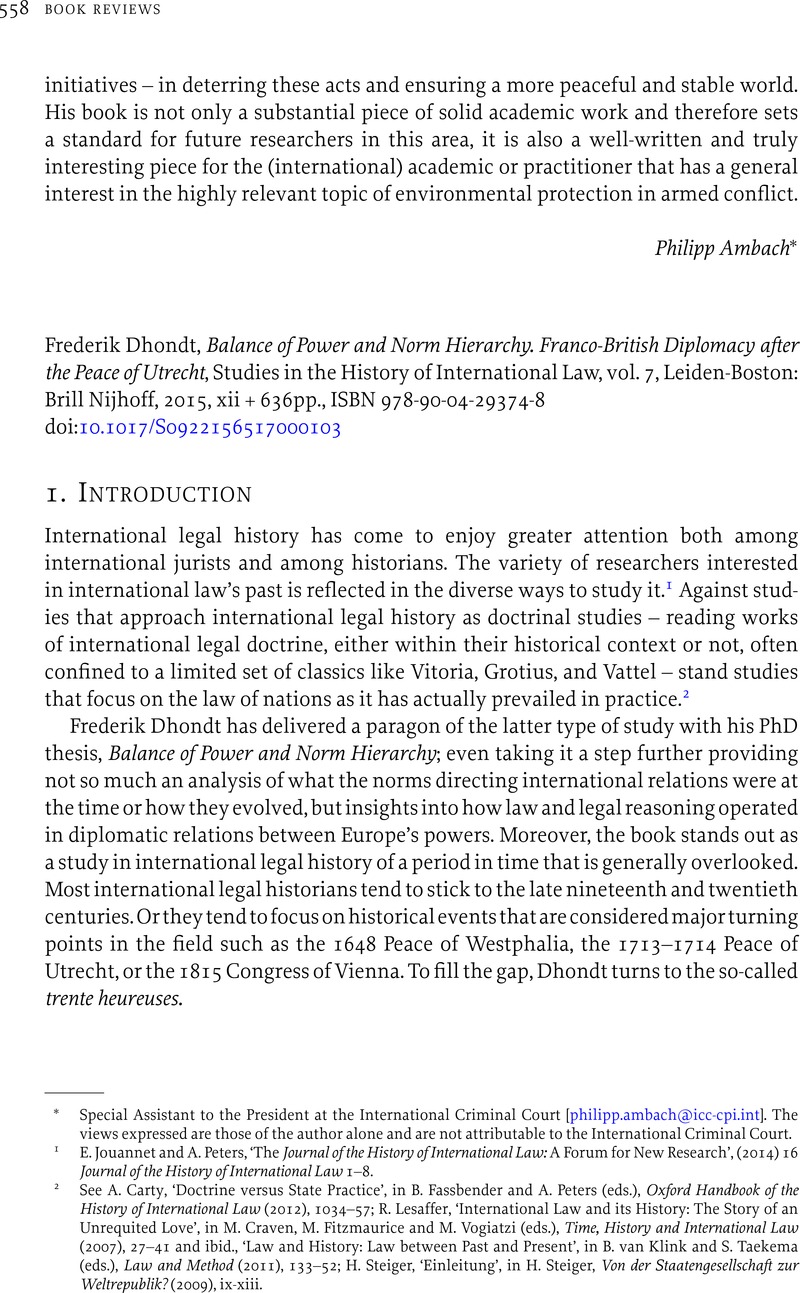No CrossRef data available.
Article contents
Frederik Dhondt , Balance of Power and Norm Hierarchy. Franco-British Diplomacy after the Peace of Utrecht, Studies in the History of International Law, vol. 7, Leiden-Boston: Brill Nijhoff, 2015, xii + 636pp., ISBN 978-90-04-29374-8
Published online by Cambridge University Press: 15 February 2017
Abstract

- Type
- BOOK REVIEWS
- Information
- Copyright
- Copyright © Foundation of the Leiden Journal of International Law 2017
References
1 Jouannet, E. and Peters, A., ‘The Journal of the History of International Law: A Forum for New Research’, (2014) 16 Journal of the History of International Law 1–8 CrossRefGoogle Scholar.
2 See Carty, A., ‘Doctrine versus State Practice’, in Fassbender, B. and Peters, A. (eds.), Oxford Handbook of the History of International Law (2012), 1034 Google Scholar–57; Lesaffer, R., ‘International Law and its History: The Story of an Unrequited Love’, in Craven, M., Fitzmaurice, M. and Vogiatzi, M. (eds.), Time, History and International Law (2007), 27–41 Google Scholar and ibid., ‘Law and History: Law between Past and Present’, in B. van Klink and S. Taekema (eds.), Law and Method (2011), 133–52; H. Steiger, ‘Einleitung’, in H. Steiger, Von der Staatengesellschaft zur Weltrepublik? (2009), ix-xiii.
3 F. Dhondt, Balance of Power and Norm Hierarchy: Franco-British Diplomacy after the Peace of Utrecht (2015), 36.
4 C. Lorenz, De constructie van het verleden. Een inleiding in de theorie van de geschiedenis (2006).
5 Dhondt, supra note 3, at 39.
6 Ibid., at 513.
7 M. Craven, ‘Introduction: International Law and its Histories’, in Craven, Fitzmaurice and Vogiatzi, supra note 2, 1 at 7.
8 Dhondt, supra note 3, at 39.
9 Lorenz, supra note 4, at 233–4.
10 H. Bull, The Anarchical Society. A Study of Order in World Politics (1977).
11 It should be stressed that from a sociological point of view norms can also form intersubjectively in social settings as internalized shared practices are cognitively turned into normative expectations. See A. Wendt, Social Theory of International Politics (1999), 266–97.
12 M. Koskenniemi, From Apology to Utopia. The Structure of International Legal Argument (2005).
13 E.g., S. Beaulac, The Power of Language in the Making of International Law (2004); J. Goldsmith and E. Posner, The Limits of International Law (2005); Wessel, J., ‘International Law as Language. Building a “Neo” New Haven School’, (2010) 23 International Journal of the Semiotics of Law 123 CrossRefGoogle Scholar–44.
14 D. Armstrong, T. Farrell and H. Lambert, International Law and International Relations (2007); J. Craig Barker, International Law and International Relations (2000); P. Diehl and C. Ku, The Dynamics of International Law (2010); A. Guzman, How International Law Works (2008); Keohane, R., ‘International Relations and International Law: Two Optics’, (1997) 38 Harvard International Law Journal 487–502 Google Scholar; M. Koskenniemi, The Politics of International Law (2011); C. Reus-Smit (ed.), The Politics of International Law (2004); Slaughter, A.M., Tulumello, A. and Wood, S., ‘International Law and International Relations Theory: A New Generation of Interdisciplinary Scholarship’, (1998) 92 American Journal of International Law 367 CrossRefGoogle Scholar–97.
15 Craig Barker, supra note 14, at 70–6; Slaughter, A., ‘International Relations, Principal Theories’, in Wolfrum, R. (ed.), Max Planck Encyclopedia of Public International Law (2011)Google Scholar, available at www.mpepil.com.
16 Dhondt, supra note 3, at 2.
17 Dhondt, supra note 3, at 36–7.
18 Ibid., at 35.
20 Putnam, R., ‘Diplomacy and Domestic Politics: The Logic of Two-Level Games’, (1988) 42 International Organization 427 CrossRefGoogle Scholar–60.
21 Dhondt, supra note 3, at 11.
22 E.g., P. Bobbitt, The Shield of Achilles (2002), 481–5. See also R. Lesaffer, ‘Peace Treaties and the Formation of International Law’, in Fassbender and Peters, supra note 2, at 71–94.
23 A. Osiander, The States System of Europe 1640-1990 (1994), 4–11. See also I. Clark, Legitimacy in International Society (2005).
24 Dhondt, supra note 3, at 507.
25 Ibid., at 512: ‘The legal framework created by diplomats restricted the freedom of political action in the idiom of legitimacy’.
26 Compare R. Gilpin, War & Change in World Politics (1981).
27 Steiger, H., ‘Rechtliche Strukturen der Europäische Staatenordnung 1648–1792’, (1999) 59 Zeitschrift für ausländisches öffentliches Recht und Völkerrecht 609 Google Scholar–47.
28 Dhondt, supra note 3, at 24.
29 The law of the Holy Roman Empire.




